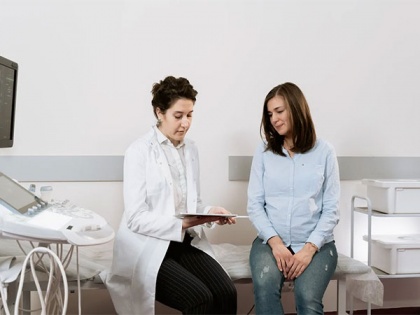Study reveals how endometriosis is connected to live births reduction before disease diagnosis
By ANI | Published: July 5, 2023 09:21 AM2023-07-05T09:21:43+5:302023-07-05T09:25:21+5:30
Copenhagen [Denmark], July 5 : According to a new study, endometriosis is associated with a decline in fertility in ...

Study reveals how endometriosis is connected to live births reduction before disease diagnosis
Copenhagen [Denmark], July 5 : According to a new study, endometriosis is associated with a decline in fertility in the years preceding a conclusive surgical diagnosis of the disorder.
The findings of the study were published in Human Reproduction, one of the world's leading reproductive medicine journals.
Researchers in Finland discovered that the number of first live births in the period before diagnosis was half that of women without the painful illness in the first study to look at birth rates in a large cohort of women who subsequently obtained surgical confirmation of endometriosis. This was true regardless of whether the women had ovarian, peritoneal, deep endometriosis, or another kind of endometriosis.
In addition, the researchers discovered evidence that the number of kids women had prior to being diagnosed with endometriosis was dramatically reduced when compared to women who did not have endometriosis.
Professor Oskari Heikinheimo, of Helsinki University Hospital (Finland), who led the study, said: "Our findings suggest that doctors who see women suffering from painful menstruation and chronic pelvic pain, should keep in mind the possibility of endometriosis and treat them effectively. Doctors should discuss with these women the possible effects on their fertility, in addition to the effects of their age, and the impairment of fertility should be minimised by offering relevant treatment for endometriosis without delay."
Endometriosis is a chronic inflammatory condition that affects up to about 10% of women of child-bearing age. Tissue from the lining of the womb grows in other places, such as the ovarian and fallopian tubes. Typical symptoms include painful menstruation, pain in the pelvic area, difficult or painful sexual intercourse, and difficulty getting pregnant. Correct diagnosis is often delayed by around seven years. Surgery has traditionally been the 'gold standard' for diagnosing the condition and classifying the type of endometriosis, although diagnosis by ultrasonographic findings or the symptoms alone is currently accepted.
Until now, there has been little information about the live birth rate among women with endometriosis, and little is known about the possible effects of different types of endometriosis on fertility, especially in the years before a diagnosis.
"Given the chronic nature and typical long delay in diagnosis of endometriosis, we wanted to find out if there were differences in first birth rates before diagnosis in a large group of women in the population," said Prof. Heikinheimo.
He and his colleagues looked at 18,324 women in Finland, aged between 15 and 49 years, who had surgical verification of endometriosis between 1998 and 2012. They matched them with 35,793 women of similar age who did not have an endometriosis diagnosis. The follow-up period started at the age of 15 years, and continued until the first live birth, sterilization, removal of the ovaries or womb, or until the surgical diagnosis of endometriosis, whichever came first. The group of women with endometriosis were also divided into four groups according to the type of endometriosis.
The average (mean) time of follow-up before surgical diagnosis was 15.2 years. The average (median) age at the time of diagnosis of endometriosis was 35 years.
A total of 7,363 women (40%) with endometriosis and 23,718 women (66%) without endometriosis delivered a live born baby during the follow-up period. The incidence rate of first live births among women with endometriosis was half that of women without the condition (0.51%). When analysed according to women's birth decade from 1940s to 1970s, the birth rate decreased in both groups of women. Importantly, over the decades, an increasingly lower first live birth rate was seen in women with endometriosis, compared to women without. In those women born in 1940-1949, the difference in live birth rates between the two groups was 28% before surgically diagnosed endometriosis, but this difference increased steadily to 87% by 1970-1979.
"We assume that this is associated with the older age of women when they have their first baby, earlier surgical diagnosis of endometriosis and accumulating adverse effects of endometriosis in women affected by the condition," said Prof. Heikinheimo.
The number of children that women had before their diagnosis of endometriosis was 1.93 and 2.16 for women without endometriosis.
"The possible effect of endometriosis on the desired number of children highlights the importance of early diagnosis and treatment of the disease," he said.
He continued: "It is important to note that this study reports on live births before a definitive diagnosis of endometriosis. Next, we will be reporting on the fertility rates after the surgical diagnosis and treatment of endometriosis. We hope that the fertility of women with endometriosis catches up with that of the women without the condition after surgical management."
Disclaimer: This post has been auto-published from an agency feed without any modifications to the text and has not been reviewed by an editor
Open in app